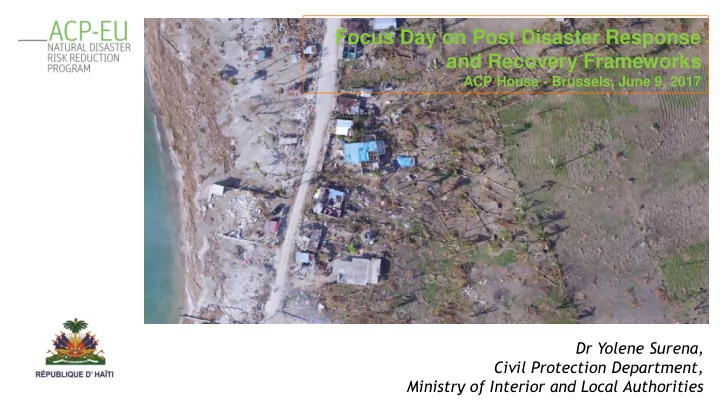

Focus Day on Post Disaster Response and Recovery Frameworks ACP House - Brussels, June 9, 2017 Dr Yolene Surena, Civil Protection Department, Ministry of Interior and Local Authorities
Haiti General Context Almost 11 million people, more than 50 % leaving in urban area Country Risk Profile: The Haitian population is one of the most exposed in the world to natural disasters — hurricanes, floods and earthquakes: 96% of its population are exposed to two or more risk. These disasters tend to affect disproportionally the poorest.
Major past events the last 50 years and impact During last 50 years, 24 cyclones impacted Haiti (13 tropical storms and 11 hurricanes) several thousands people died and every year almost 2% GDP is lost only for hydrometeorological disasters
Major past events the last 20 years and impact In addition to hydrometeorological event, a catastrophic earthquake hit Haiti in 2010, killing more than 230,000 people and causing more than 120% GDP (about US$ 8 billion)
Hurricane Matthew: October 2016 The Hurricane Matthew made landfall in Haiti on October 4 , 2016 as a Category 4 hurricane . The hurricane created: maximum sustained winds of 230 km/h caused heavy rain (up to 600 mm in one day), storm surges and landslides Wave tidal has been estimated at 2-3 meters above the normal level.
Hurricane Matthew: October 2016 Les Anglais before the event - Orthophoto 2014
Hurricane Matthew: October 2016 Les Anglais after the event - Drones Images Octobre 2016
Hurricane Matthew Video before – after: https://www.youtube.com/watch?v=md7tdd5vIMk
Hurricane Matthew: key numbers About 550 people died 180,000 people in shelters 2 million people impacted 2.8 billion dollars, about 32% GDP impact
Key milestones, three requests and two products October 4: Matthew impacted Haiti 3 days after (October 7): Ministry of Public Works requested help for a “technical evaluation” of the damages to enable an early start of recovery activities, writing to the World Bank 4 days after (October 8): Ministry of Planning asked technical and financial support in conducting a PDNA , writing to UNDP , 9 days after (October 13): Ministry of Finance requested technical support for a Rapid damages and losses assessment , writing to the World Bank 18 days after (October 22): Rapid damages and losses assessment completed and presented by the Ministry of Finance, with the technical and financial support of Inter-American Development Bank and World Bank, as well as few UN agencies 4 months after (February 3): PDNA completed and presented by the Interim President, with the technical and financial support of European Union, all UN agencies, Inter-American Development Bank and World Bank
Lessons learned and challenges 1. Today, government and people are requesting and expecting information and results in days or weeks, not in months. Therefore: Objective, timing and methodology of a post-disaster assessment should be tailored based on the government needs (and not imposing a global standardized methodology): each country and each disaster is different.
Lessons learned and challenges 2. There is a tremendous increase in quality and accuracy of remote sensing analysis: Therefore Haiti has a tremendous amount of high resolution data (including geolocation for the schools, hospitals, etc.), providing the country with a very precise baseline, so post-disaster assessment can be significantly speed-up by using remote sensing data support (drone and satellite) comparing with a high level of accuracy the ‘before’ – baseline - and ‘after’ – drone and satellite
Lessons learned and challenges 3. International Partners and Donors have their own standard operating procedures to trigger support to the country: Therefore: Ex-ante discussion and agreement about the procedures and options for post-disaster assessment tailored for the country needs and capacity, in particular pre-agreement on collaboration between international partners to support post-disaster assessment
Lessons learned and challenges 4. Once procedures and a country-tailored assessment methodology is agreed, Then Government capacity for his own post-disaster assessment methodology has to be reinforced well before the disaster, at local as well as national level, using all the capacity and tools available in country, with the ultimate goal to build country capacity to make the assessment on its own
Mesi Anpil (thank you)
Recommend
More recommend